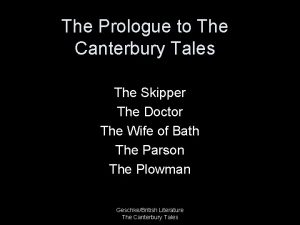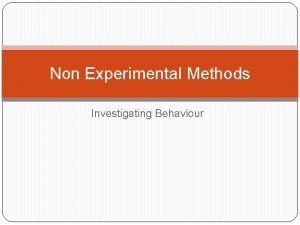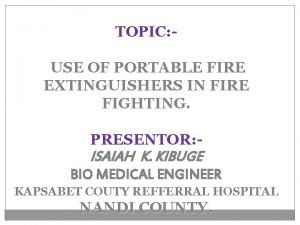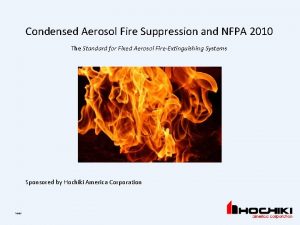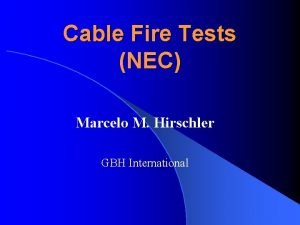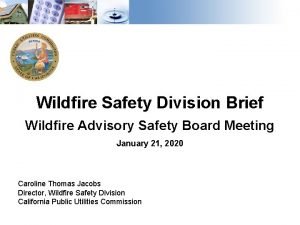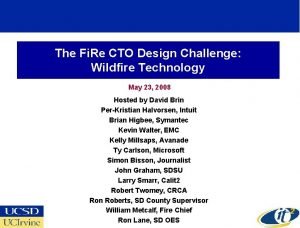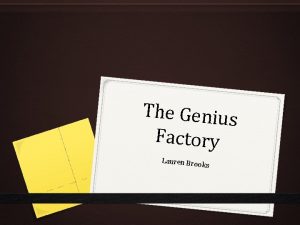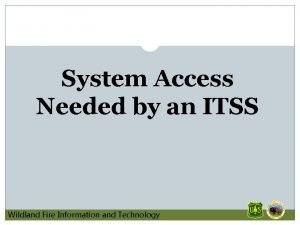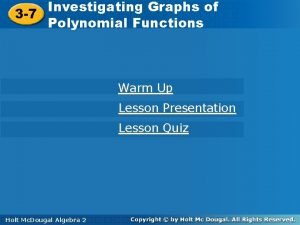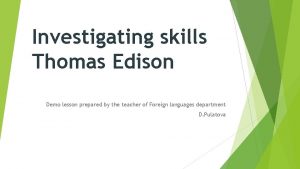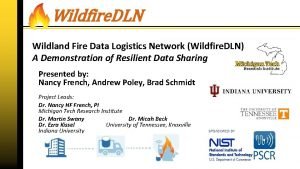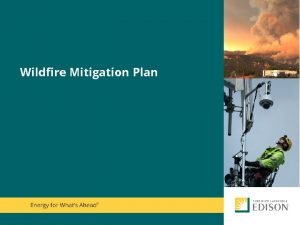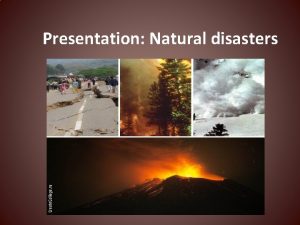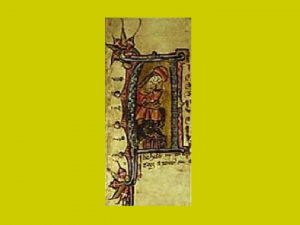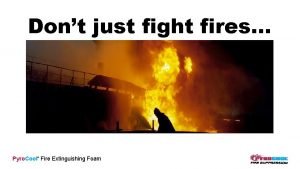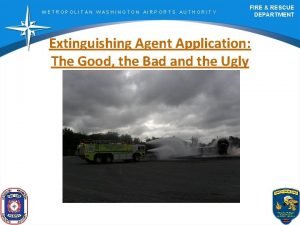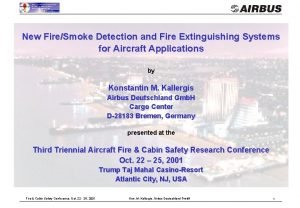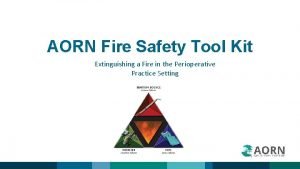Investigating Wildfire Extinguishing Methods Helen Stritzel Carmen Plowman

















- Slides: 17

Investigating Wildfire Extinguishing Methods Helen Stritzel, Carmen Plowman, Juan Torres, Weiliang Sun, Grant Matthews

• How effective are different methods, including type of suppression and application, of varying flame retardants used to suppress a fire in an alpine environment? Testable Question

• If we test different kinds of commonly used fire retardants, then Monoammonium Phosphate will be the most effective fire suppression technique because when dispersed, it cloaks potential fuel sources with a carbon substance when heated, as opposed to saturating the fuel, absorbing heat, or extinguishing the flames on a smaller scale. Hypothesis

Types of Flame Retardants

• MAP is a fire retardant, so it is applied around a wildfire to contain it • Aerially distributed in powder form to forests and brush lands • Remains effective until removed manually or by rain http: //www. qrbiz. com/buy_Map-of-the-Ancient-World Monoammonium Phosphate

How it Works 1. A cation is released when Monoammonium Phosphate is heated 2. The cation reacts with cellulose from the fuel, producing an ester. 3. The ester thermally degrades, releasing water vapor and carbon that coats the fuel and renders it fireproof Monoammonium Phosphate http: //chemistry. about. com/od/chemistryjokes/ig/Chemistry-Cat---Cations. htm

• Mechanism • Mixes with water to become foam • Reduces surface tension of water and allows fuel to become saturated faster • Creates a protective foam blanket around fuel Phos-Chek WD 881 http: //en. wikipedia. org/wiki/Phos-Chek

• Benefits • Applied aerially • Is not a significant hazard to human health during its manufacture or subsequent use. • Drawbacks • If deposited into a lake or stream, it could result in a fish-kill. Phos-Chek WD 881

• Mechanism • Extinguisher filled with pressurized CO 2 • Smothers flame, depriving it of oxygen • By far the most common extinguisher for small-scale fires • Safe and reliable Carbon Dioxide A CO 2 fire extinguisher. Image: http: //frakerfire. com/blog/wpcontent/uploads/2012/09/co 2 -mri. jpg

• Benefits • Portable • No cleanup necessary • Drawbacks • Purely small-scale method • Expensive to store and maintain pressure, especially as volume increases • Impractical for wildfire use Carbon Dioxide

• Mechanism of fire suppression • Superabsorbent polymer (hydrogel) • • Large molecule with many repeating subunits “Slurry” – liquid blended with solid (similar to concrete) Soaks hundreds of times its weight in water Surrounds w/polymer frame, retaining moisture • Main Use • Thermal fire protection (i. e. structural protection) Thermo Gel Fire Suppressant Firefighters spread thermo gel to reduce fire spread. Image: http: //ktar. com/? nid=6&sid=619505

• Benefits • Can be applied ahead of time to staunch fire spread • Protects homes and other areas • Drawbacks • Difficult cleanup Thermo Gel Fire Suppressant

• “Clean Agent” • Nonconductive • Volatile (evaporates quickly at room temperature) • No residue • Mechanism • Stops combustion chemically by reacting with the fire’s requisite fuel and restricting oxygen flow Halon A Halon fire extinguisher. Image: http: //upload. wikimedia. org/wikipedia/co mmons/d/d 9/Fire. Extinguisher. ABC. jpg

• Benefits • Clean agent • Quick and effective • Drawbacks • CFC (Chlorofluorocarbon) Effect of CFCs on the atmosphere. Image: • Contribute to atmospheric ozone depletion http: //www. daviddarling. info/images/chloro fluorocarbons. gif • Usage ended in 1994 w/government restrictions • Relatively small-scale extinguishing technique (may not apply to wildfires) Halon

1. The experimenters will set up a controlled mock burn site created from typical alpine fuel. . 2. The fire retardants, MAP, Phos-Chek, and Thermo Gel, will be applied from a height simulating aircraft movement, and the fire extinguishers, Halon and Carbon Dioxide, will be applied to the fire using safe techniques. 3. The fire will then be set for each trial and the time taken for the fire to either run out of fuel from being contained or extinguished using the agents mentioned about will be recorded. Proposed Investigation

Variables • Independent Variable: Type of fire suppressant • Dependent Variable: The amount of time taken for a set fire to be extinguished • Controlled Variables: The type of fuel used in each trial, the same amount of fuel used and the same surrounding environment. Proposed Investigation

• • Basic facts about Halon. (n. d. ). Retrieved March 11, 2014, from http: //www. h 3 rcleanagents. com/ support_faq_2. htm Fire & aviation management. (n. d. ). Retrieved March 7, 2014, from http: //www. fs. fed. us/fire/ retardant/ Firefighters say gel works, but don't expect rush to stockpile it. (2007, October 12). Retrieved March 10, 2014, from http: //ktar. com/? nid=6&sid=619505 Firefighting chemicals. (n. d. ). Retrieved March 7, 2014, from http: //www. cfs. sa. gov. au/site/ about_us/what_we_do/aerial_firefighting/firefighting_chemicals. jsp Makowka, N. (n. d. ). Wy carbon dioxide (CO 2) in fire suppression systems? Retrieved March 11, 2014, from http: //www. nafed. org/whyco 2 Phos-check WD-881 Class A foam. (n. d. ). Retrieved March 7, 2014, from http: //www. phoschek. com. au/foam/phos-chek-wd-881 Phosphate based forest fire retardants. (n. d. ). Retrieved March 7, 2014, from http: // www. phosphatesfacts. org/pdfs/Phosphate%20 Based%20 Forest%20 Fire%20 Retarda nts. pdf Wildland fire chemical products toxicity and environmental concerns general information. (2007, January). Retrieved March 7, 2014, from http: //www. fs. fed. us/rm/fire/documents/ envissu. pdf Bibliography
 Piers plowman
Piers plowman Skipper the canterbury tales
Skipper the canterbury tales Methods of investigating behaviour
Methods of investigating behaviour Teaj
Teaj Midtown computer solutions helen speaking
Midtown computer solutions helen speaking Starvation method of extinguishing fire
Starvation method of extinguishing fire Aerosol system nfpa
Aerosol system nfpa Proengineer wildfire
Proengineer wildfire Wildfire lyrics seafret meaning
Wildfire lyrics seafret meaning Wildfire
Wildfire Bønder telemacos pef htc wildfire test
Bønder telemacos pef htc wildfire test Wildfire safety advisory board
Wildfire safety advisory board Wildfire technology integration
Wildfire technology integration 1999 wildfire genius
1999 wildfire genius Ftp wildland fire
Ftp wildland fire Cell theory contributors
Cell theory contributors 6-7 investigating graphs of polynomial functions
6-7 investigating graphs of polynomial functions Thomas edison lesson
Thomas edison lesson

